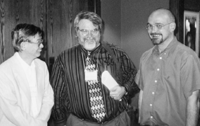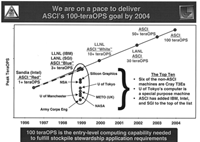SIAM Sponsors 8th in Combustion Series
October 21, 2000

Invited speaker James T'ien of Case Western Reserve University (left), with organizing committee co-chair D. Scott Stewart of the University of Illinois, Urbana-Champaign (middle), and Andrew King of the University of Birmingham.
The Eighth International Conference on Numerical Combustion was held March 5-8, 2000, on Amelia Island, near Jacksonville, Florida. Conceived in the 1980s, the combustion conference series has become a recognized and unique international forum with an exclusive focus on all aspects of the numerical modeling of combustion---from computer science and software engineering to numerical analysis, asymptotic computations, and experiment. The conferences are held every other year, with the sites alternating between Europe and the U.S. The Amelia Island meeting, the fourth held in the U.S. (and sponsored by SIAM), drew 182 researchers from 18 countries.
There is no doubt that innovative numerical algorithms for computational fluid dynamics developed in the 1980s and 90s are having a major impact on the numerical simulation of combustion today. At the meeting, contributed papers and minisymposia alike dealt extensively with issues that arise in, for example, higher-order discretization schemes and adaptive mesh refinement, multigrid methods, sparse solver technology, and applications of level sets. Cited by participants as an exciting development on the algorithmic side is the emerging use of wavelet techniques as a rational and promising way to carry out adaptive mesh refinement.
On the physical modeling side, the growing success of large eddy simulation (LES) was identified as one exciting development. No fewer than 30 speakers discussed the application of LES to combustion. Indeed, turbulent combustion and modeling turned out to be a large unplanned theme of the meeting. The many talks on reduced-chemistry models and intrinsic low-dimensional manifolds also gave rise to another theme: the theory for reducing the complexity of large chemical networks in combustion.
A unique aspect of the meeting was a special minisymposium, Numerical Combustion Issues in the ASCI Alliance Code Development; the organizer, Charles Westbrook of Lawrence Liver-more National Laboratory, also gave an invited presentation. As part of the ASCI (Accelerated Strategic Computing Initiative) program, the U.S. Department of Energy funds five university mega-centers (five-year awards, approximately $5 million/year); the aim of the centers, called Academic Strategic Alliance Partners (ASAP), is to assist the three DOE defense labs (Lawrence Livermore, Los Alamos, and Sandia) in developing technology that will lead to advanced simulation capability. The hope is that advanced simulations of complex multicomponent engineering systems will ultimately replace nuclear testing, which is now unilaterally banned by U.S. policy.
The ASAP centers are all engaged in combustion-related simulation. Indeed, given their considerable resources, the ASAP centers reflect a sizeable concentration of U.S. federal funding for combustion science at academic institutions. Discussions at the meeting revealed intense interest on the part of senior European scientists in how the ASAP centers were faring.
The ASCI minisymposium speakers discussed the various combustion activities under way at the centers. Phillip Smith of the University of Utah described the modeling of large pool fires with hydrocarbon fuels. Thomas Jackson of the University of Illinois reported on progress in modeling combustion in solid rocket motors at the Illinois center (see SIAM News, May 1998, for center director Michael Heath's report on Illinois goals and plans at startup time). Representing the Stanford center, Heinz Pitsch discussed the group's effort to model aircraft turbine engine combustion. Joe Shepherd and Chris Eckett discussed the Caltech project on the simulation of high explosive and propellant combustion. Jens Niemeyer represented the ASCI "Flash" center at the University of Chicago, which studies the physics of astrophysical thermonuclear explosions (i.e., novae, x-ray bursts, and type Ia supernovae) with the help of multidimensional hydrodynamical simulations, making extensive use of methods developed for combustion science.
At the heart of the program were the six plenary talks. Leading off was Stuart Cant of the University of Cambridge; his talk, "Premixed Turbulent Combustion: DNS into Modeling," was a comprehensive review of the state of the art. Cant was followed by Sergei Frolov of the Russian Academy of Sciences, with a talk titled "Numerical Modeling of Combustion Control in Ramjets."
Charles Westbrook opened the Tuesday sessions with insights into the contributions of the ASCI program to combustion modeling (see Figure 1). The talk given by Timothy Parr of the U.S. Naval Air Warfare Center later that day, "Experimental Measurements of Solid Propellant Flame Structure for Model Validation," was a definitive discussion of experiments on solid propellant flames. On Wednesday, Peter Lindstedt of Imperial College, United Kingdom, spoke on the intrinsic constraints imposed by the interaction of physical and chemical processes occurring on different time scales, in a talk titled "Aero-thermochemistry of Flames." And anchoring the plenary talks was a review of the role of radiation in microgravity flames, by James T'ien of Case Western Reserve University.

The ASCI (Accelerated Strategic Computing Initiative) program was the focus of several talks at the meeting. Shown here is an illustration from Charles Westbrook's invited talk on the contributions of the ASCI program to combustion modeling.
Twelve invited and several contributed minisymposia were a major part of the meeting. Again, the speakers considered a broad range of topics in combustion science that are of interest to the simulation community. The sessions and organizers were:
Simulation of Deflagration to Detonation Transition (Alexei Khokhlov, Naval Research Laboratory); Edge Flames (John Buckmaster, University of Illinois); Adaptive Wavelet Methods Applied to Numerical Combustion (Samuel Paolucci, University of Notre Dame); Numerical Simulation of Laminar Reacting Flow with Complex Chemistry, I and II (John Bell, Lawrence Berkeley Laboratory); Large Eddy Simulation of Non-premixed Turbulent Combustion, (Heinz Pitsch, Stanford, and Johannes Janicka, University of Darmstadt); Combustion of Energetic Materials (Steven Son, Los Alamos National Laboratory); Detonation Dynamics and Stability (Mark Short, University of Illinois); Direct Simulation of Turbulent Combustion (Christopher Rutland, University of Wisconsin); Numerical Combustion Issues in the ASCI Alliance Code Development (Westbrook); Advanced Numerical Modeling for Multidimensional Laminar Flames, (Alexandre Ern, CERMICS ENPC, France); Numerical Simulation of Heterogenous Catalysis for Pollution Control (Eduardo D'Azevedo and Stuart Daw, Oak Ridge National Laboratory).
Contributed papers were given in sessions organized around several themes: large eddy simulation, laminar flames, sprays, kinetics, flamelets, particles and stochastic modeling, numerical techniques, porous and heterogeneous combustion, direct numerical simulation, microgravity, furnaces/engines, radiation, software development, ignition, turbulence models, detonation, and parallel computing.
Suggested themes for future conferences include the use of large-scale computations for predicting combustion phenomena in engineering and industrial applications, and the invention and improvement of algorithms for hybrid schemes. Planning for the next meeting, to be held about two years from now in Europe, has already begun. A spectacular venue in Italy is a possible site. Norbert Peters of RWTH Aachen and Jurgen Warnatz of the University of Heidelberg, Germany, have agreed to be the scientific organizers.
D. Scott Stewart, co-organizer (with John Buckmaster and Mitchell Smooke) of the Eighth International Conference on Numerical Combustion, is a professor in the theoretical and applied mechanics department at the University of Illinois, Urbana-Champaign.

